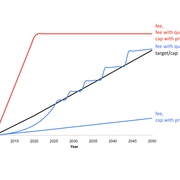Abstract: Four cost-effective frameworks for pricing greenhouse gas emissions currently receive widespread attention: cap-and-trade, emission fees, and hybrid cap-and-trade approaches that include upper or lower limits on permit prices (price ceilings or floors). This paper develops a fifth framework that uses an emission fee with an upper limit on the quantity of emissions—a quantity ceiling—and compares the impact of each framework on emission prices and quantities. Cap-and-trade with a price ceiling minimizes price increases for emitting activities in all cases whereas an emission fee with a quantity ceiling maximizes emissions reductions. Thus, the choice of framework influences policy outcomes because each framework is more or less suited to particular policy goals. Whether pursuing one potential policy goal serves society's interests best depends on the eventual consequences of climate damage and emissions pricing, which are uncertain when policy choices are made. Policy updating over time may reduce but likely cannot entirely eliminate the differences in outcome that arise due to framework choice. Therefore, the “best” framework for emissions pricing depends on subjective preferences regarding the relative importance of different policy objectives, most notably whether one is more risk averse to climate damages or emissions price increases.
Request a reprint: [email protected] or Download the Paper (behind paywall): here
